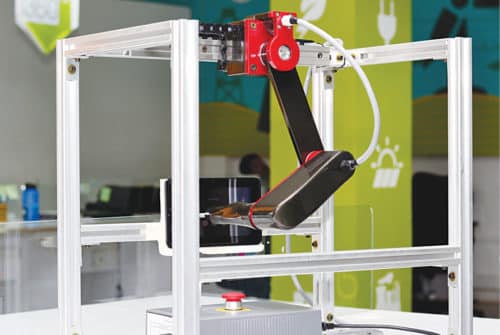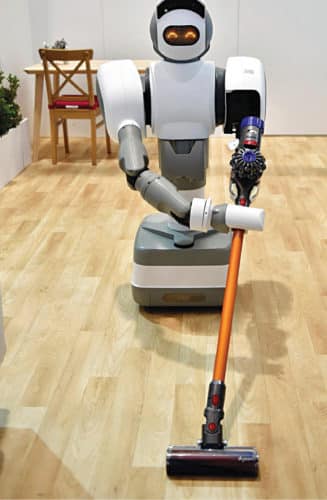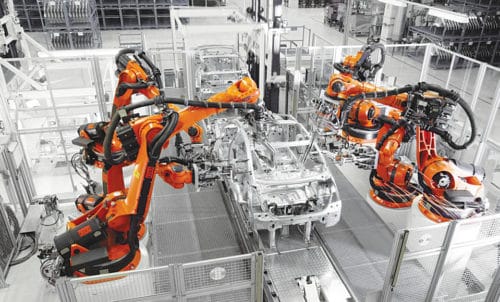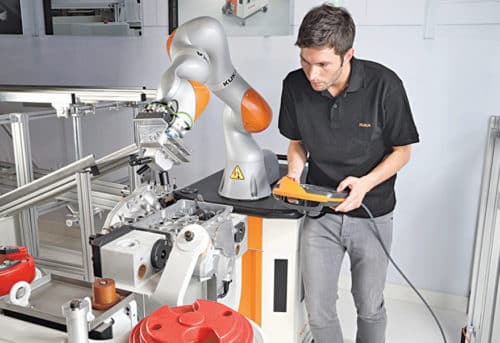Scientists all over the world are developing intelligent robots that can observe and learn from experience and human behaviour. The robots can then collaborate with humans across a range of sections.
As technology advances, the range of potential applications for robots grows even wider. Robots are becoming more flexible, accurate, safer and faster. These are more energy efficient, compact and lighter. Modern robots are easier to program and capable of integrating with a wider range of machines.
Use of industrial robots has increased steadily in recent years in India. Along with with the cloud, these play a key role in production, as the most flexible elements. Robotic automation is indispensable for anyone wishing to rise to the challenges of Industry 4.0.
Amit Maheshwari, technical lead – robotics and automation, Ingen Dynamics Inc., says, “Latest technology in robotics is integrating robots with artificial intelligence (AI), so that these can interact with humans in a better way. This is done by making the robots understand emotions, faces and expressions of people. The robots could then replicate the same, and interact in ways similar to having a normal conversation. We would not know over a phone call if the other side is a human or robot.
“Personal robots is a recent application area. Warehouse automation is another. Robots like unmanned vehicles are being used in the defence sector. Exploration is going on with underwater robots. Next stage of evolution is more flexible industrial robots.”
Achu Wilson, co-founder, Sastra Robotics, explains, “What separates smart robots from traditional industrial automation is the capability of the robots to adapt to various situations and work as intended. This capability is mainly brought in by advances in AI, machine learning and sensors, among others.
“Traditional robots work excellently in well-defined, controlled factory or production environments. These do not have sensing or decision-making capabilities to operate in regular, cluttered human environments. For example, robot manipulators are used in factories to pick/place/process thousands of similar items. But these cannot perform well with other objects.
“Amazon’s picking challenge aims to develop such intelligent capabilities for robot arms that enable these to pick up thousands of varying objects in a typical e-commerce warehouse. These sensing and decision-making capabilities to operate in unstructured human environments will make the robots smart.”
Cobots for industrial applications
A collaborative robot, or cobot, works interactively with humans in a shared workspace. It helps the human operator(s) to fulfill tasks and minimise risk in situations such as transportation and handling of sharp, pointed, hot or heavy work pieces.
Cobots are easy to use, flexible and safe. These are easy to program and can learn independently using machine learning. Instructions can also be given using a graphic user interface other than coding. Anyone can flexibly program cobots for a variety of tasks.
Wilson adds, “Application areas of smart robots are mostly in human environments. These days, cobots are increasingly used in production environments, because these can augment the capabilities of humans to work safely hand-in-hand with them.
“Another big application area is consumer robotics, which includes robots that can work in human homes.”
Cobots versus industrial robots. Cobots are designed to work along with human operators, while industrial ones work in place of humans. Cobots are capable of self-learning during a job, while the latter require an engineer to write new code for any change in process.
Cobots are not designed for heavy manufacturing as these work closely with humans. Hence, these are safe enough to function around humans. Industrial robots, on the other hand, can handle heavier and larger materials, and require fencing to keep humans out of the workspace. Cobots immobilise at the slightest touch due to sophisticated sensors and, thus, prevent any danger to nearby people.
Developing smart robots
Building smart robots requires automation, AI and machine learning, for human-robot collaboration. Integrated sensors in robots have made it possible to handle assembly tasks accurately.
A smart robot detects its environment, learns from it and responds accordingly. To detect the environment, it requires sensors like lidar, temperature, depth, proximity and camera. The sensors interact with the environment in real time and generate the required information and responses. The robot checks the information using various algorithms to generate the required responses as per the situation or scenario. It then decides how to act.
Pradeep Shoran, assistant general manager – marketing, Kuka Robotics, says, “We need to understand the requirements of a customer and then build our solution around it. The trend is moving towards greater customisation, more product variants, away from rigid mass production. Hence, personalised products that a customer can self-configure on a computer and order on the Internet are in demand.
“Production of goods need to become considerably more flexible in this new world. To be able to achieve this, new production concepts are required that enable extremely versatile production on an industrial scale and networked throughout the process chain. Production logistics will undergo fundamental changes. Robots will move freely around the production facility on mobile platforms, performing a wide range of different tasks and interacting with humans.”
Applications of smart robots
The smart robot market is growing rapidly with the adoption of autonomous AI-enabled robots for personal and professional services. Applications that utilise smart robots can perform the tasks better, faster and accurately. Various fields of application of smart robots include aerial (drones), industrial (heavy-duty automated machines) and underwater robotics, robotics for intelligent transportation systems, scientific research, manufacturing, mining, agriculture, construction, search-and-rescue operations, space research, medical assistance and personal assistance.
Shoran says, “Human-robot collaboration and mobile robotics are prominent emerging trends in robotics. For example, LBR iiwa is an autonomous, mobile, safe, sensitive and lightweight robot, controllable over a mobile platform. It is based on human-robot collaboration and works as a colleague for its operator, directly supporting the latter. It can independently fetch tools from the warehouse and load those into the tool magazines on the machines without additional safety equipment. The operator has unhindered access to machines. If the production sequence changes, the route taken by the autonomous vehicle changes without altering the layout of the machines. The manufacturing process is geared towards maximum productivity and not determined by the constraints of rigid automation.”
Some commercially-available robots
Wilson mentions, “Sastra provides solutions to automate the testing of real devices. Traditional robots are used for manufacturing processes. We employ robots to test devices like smartphones, car infotainment systems, consumer electronics like printers and copying machines, and even avionics control panels. These devices are tested for reliability as well as functionality. Testing when done by humans is time consuming and prone to errors. Our robots test these devices in a much faster and reliable way, and generate test reports based on test results.”

Maheswari adds, “A home assistance robot is the next-generation smart, interactive and social family robot. It can play with kids, manage schedules, help with household work, and keep the home safe and connected. It can aid in tasks such as cooking and yoga, using an interactive projector. The multimedia projector can convert any wall in to a movie screen. It also lets you play interactive games.
“The robot converts your home into a smart one, enabling you to control compatible lights, doors and appliances. It comes with a storyteller feature that can read stories. The robot patrols your home using powerful sensors and smart intruder alerts.”
Some latest household assistant robots are KURI, Aeolus, Ubtech Robotics Walker, Buddy by Blue Frog Robotics, Sony’s Aibo, Sophia by Hanson Robotics, Aido and Piaggio.
Shoran adds, “Kuka’s automation is the decisive key to higher productivity, higher reliability and greater cost-effectiveness.


“Robots have been extensively used in sectors such as food, plastics, metal, electronics, medical and entertainment, besides the automotive industry. These can perform transfer tasks, even in small batch sizes, safely and without errors using information received from the cloud. These can then report the experiences back to the cloud, where these can be evaluated for optimisation, documentation and quality-assurance purposes. Not only the robots, but also machine tools and other devices in the manufacturing facility can be connected to Kuka cloud to collect and analyse data for optimising the production processes.”
Examples of such robots include the ones by Infineon, Bajaj Auto, Aurolab, Sastra and ABB.

Machine learning
Machine learning has had a significant impact on smart robotic technologies. It integrates vision, imitation learning, self-supervised learning, and assistive and medical technologies.
Robot vision helps in structured prediction learning techniques and inspection systems like identification and sorting of objects.
Imitation learning provides observational learning used for humanoid robots. It is required for construction, agriculture, search and rescue, military and other areas.
Self-supervised learning enables robots to generate their own training courses to improve performance. It includes road detection algorithms and more to improve performance.
Machine learning-based assistive technologies are being developed to combine assistive machines with autonomy, to help people with disabilities and the elderly.
Robotic applications are enhanced when barcode readers and machine vision are added to these. A smart camera on a robot is required for machine learning. It acts as a set of eyes that help the robot compare the image of a product against a set of criteria, and make sure that the criteria are met.
Mounting a camera on an industrial arm provides a variety of features for inspection. Robotic applications that require a smart camera are pick-and-place, assembly, packaging and palletising, quality inspection, screw driving, polishing, labelling, welding, molding, lab testing and others. For example, in assembly, machine vision guides the parts to be assembled, while the barcode reader reads the label on the parts to make sure correct parts are assembled.
Conclusion
We are living in a transformative and an automotive era, where advancements in technology are leading to wider adoption of smart robotics. We are constantly in touch with new forms of technology that make daily life easier. Robotic automation is replacing heavy-duty and risky tasks performed by humans. Automation will lead to many industrial jobs overtaken by robots. At the same time, new and advanced technology jobs will be created elsewhere.










